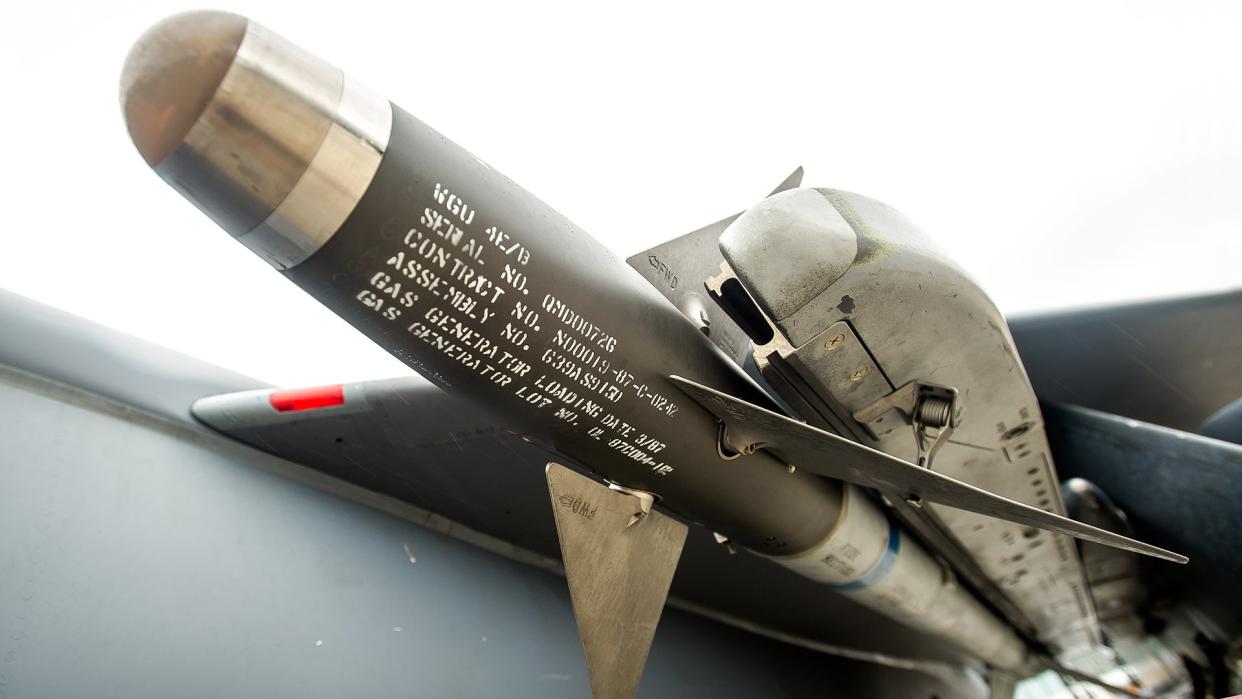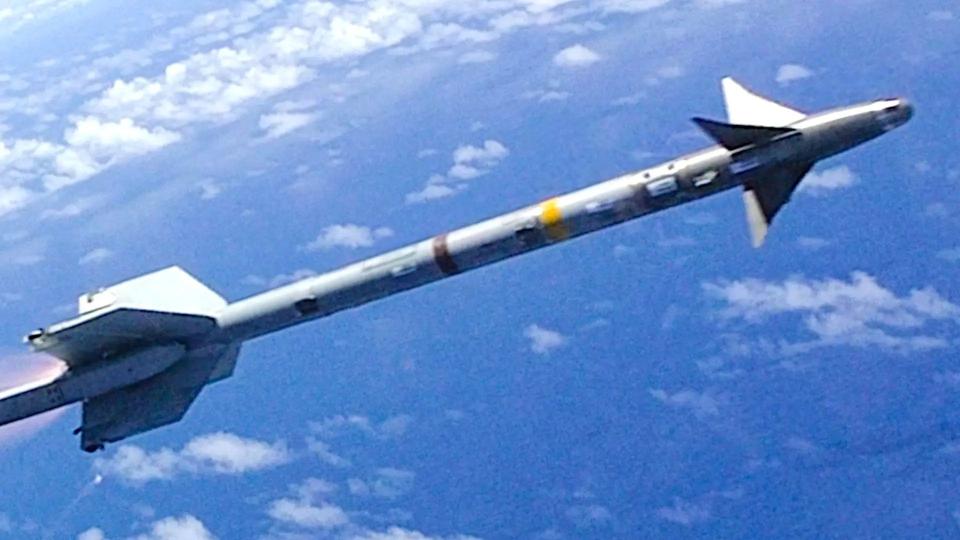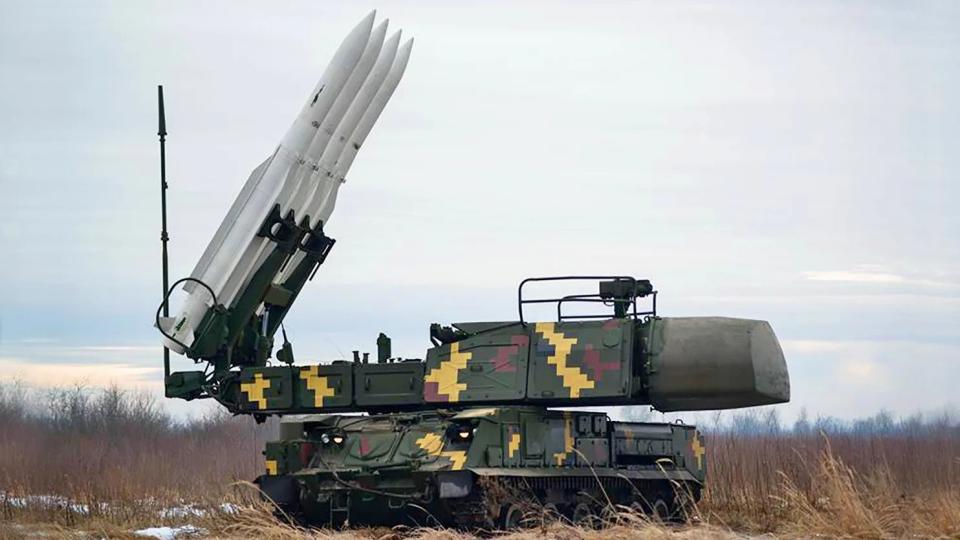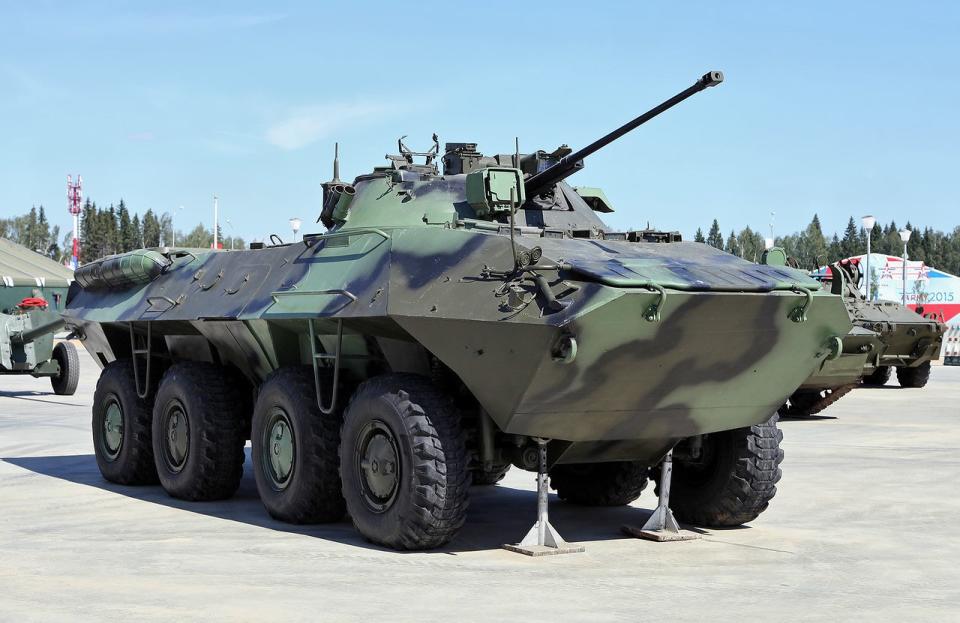Ukraine Situation Report: 'FrankenSAM' To Speed Delivery Of Air Defenses

An ad hoc ground-based short-range surface-to-air missile system that uses the AIM-9M Sidewinder as its effector is reportedly part of a larger Pentagon project known as FrankenSAM that aims to bolster Ukraine's air defenses. U.S. Secretary of Defense Lloyd Austin first revealed the existence of the AIM-9M-based air defense system earlier this week and said that the first examples would be delivered to Ukrainian forces soon. Turning Sidewinders into surface-to-air missiles was a possibility The War Zone had raised previously.
The AP was the first to report on FrankenSAM earlier today. Exactly when this effort started isn't clear, but the wire service says that the program "began months ago but has grown over time." The U.S. military did announce a sweeping plan to help expand and improve Ukraine's air and missile defenses last year.
"The U.S. has been able to improvise and build a new missile launcher from radars and other parts contributed by allies and partners," according to the AP. "The system will be able to launch AIM-9M Sidewinder missiles, which the U.S. announced Wednesday it will send to Ukraine in the latest aid package."

The first public mention of AIM-9Ms for Ukraine came in the announcement of another U.S. aid package back in August. At that time, how Ukrainian forces might use these missiles was unknown, but using them as ground-launched air defense weapons was a distinct possibility.
It is worth noting that the AIM-9M is a heat-seeking missile, though a radar could still be used to cue the launcher firing it to point at the target. Since the AIM-9M doesn't have high off-boresight engagement or lock-on-after-launch capability, this version of the Sidewinder would still need to pick up the thermal signature of whatever that threat might be using its own seeker before launch. The War Zone explored various possibilities of what might go into this new AIM-9M-based air defense system just earlier this week.
The U.S. military has already been known to be facilitating the integration of older AIM-7 Sparrow/RIM-7 Sea Sparrow radar-guided missiles onto Ukraine's existing Soviet-era Buk surface-to-air missile systems. This work, which AP has reported is also part of the FrankenSAM project, could offer some broad insight into what the final AIM-9M-based system might look like.

Defense24 in Poland previously raised the idea of combining Soviet-designed Osa air defense vehicles, which Ukraine also already has in service, with AIM-9s. Polish defense contractor PGZ has pitched a modified Osa capable of firing the IRIS-T heat-seeking missile in the past and actually made significant progress in developing a prototype. Ukraine has also received air defense systems using surface-launched IRIS-T missiles from Germany.
https://twitter.com/JakubPalowski/status/1712379481401278785?s=20
There have been reports in the past that the U.S. military has been digging into its own secretive stocks of Soviet-designed air defense systems to find things that might be useful to Ukraine. These items were acquired as part of so-called Foreign Materiel Exploitation (FME) efforts, which involve deep intelligence analysis and testing and evaluation of non-U.S. weapon systems and other military equipment, as you can read more about here.
Beyond just helping to bolster Ukraine's air defense capabilities and capacity, combining old Soviet-era air defense systems with Western missiles offers important logistical benefits. Ukrainian stocks of the missiles those systems were designed originally to fire are dwindling, but there are large stockpiles of AIM-7/RIM-7s and AIM-9Ms in the United States and other NATO countries. U.S. and NATO military forces are also steadily phasing out these older missiles, making them more readily available for transfer.
The War Zone has previously highlighted how valuable National Advanced Surface-to-Air Missile Systems (NASAMS) are for Ukraine because of the similarly wide availability of AIM-120 Advanced Medium-Range Air-to-Air Missiles (AMRAAM) to 'feed' them.
https://www.youtube.com/watch?v=YuIk4oqWj1w
The AP has reported that U.S. military is working to supply older HAWK (Homing All-the-Way Killer) missile systems to Ukraine as part of FrankenSAM. However, according to the AP's story, those systems are just being upgraded to a more modern standard that already exists rather than being completely repurposed. Spain has already announced its own plans to send HAWKs to Ukraine and more may come from Taiwan, and you can read more about what they could offer in our previous report.
Before getting into the rest of the latest news from Ukraine, The War Zone readers can get caught up with our previous rolling coverage here.
The Latest
Conflicting claims are swirling about a new round of reported Ukrainian attacks using maritime drones on Russian warships in and around Sevastopol Bay on the occupied Crimean Peninsula.
Reports today citing anonymous sources within Ukraine’s State Security Service, or SBU, say that maritime drone attacks damaged a Russian Project 21630 Buyan class missile corvette and the Project 22160 Vasily Bykov class patrol ship Pavel Derzhavin in separate attacks today and on Wednesday, respectively. Another unsuccessful attack was reportedly mounted against the submarine Alrosa, a unique subvariant of the Kilo class with a pump-jet propulsor.
https://twitter.com/MrFrantarelli/status/1541676935306158080
"After the first [attack], Russian minesweepers and divers were unable to discover our ‘know-how,’" one anonymous SBU official told The Washington Post. "[The SBU] warns Muscovites that there is no need to go through Ukrainian waters if you want to preserve at least some remnants of your fleet."
The maritime drones that were reportedly employed in these attacks have been described as "experimental," but also as "sea babies." The SBU has previously shown a kamikaze drone boat design called the "Sea Baby."
https://twitter.com/nexta_tv/status/1691744422096982417
At the time of writing, the Russian government does not appear to have issued any formal statements about any of these incidents. No corroborating imagery or other evidence of the Buyan class corvette or the Alrosa looks to have emerged so far, either.
There had already been reports about an attack on the Pavel Derzhavin. Captain 3rd Rank Dmytro Pletenchuk, Ukrainian Navy spokesperson told Radio Svoboda, U.S. government-funded Radio Liberty's Ukrainian service, that "I can't give you any information about the circumstances of this incident, let's call it that, but it is a fact."
However, user @Capt_Navy on X, formerly Twitter, who is a retired Russian Navy officer, shared a picture that he says shows Pavel Derzhavin in port in Sevastopol on October 12 with no indications of any serious damage.
https://twitter.com/Capt_Navy/status/1712402087504466248
In addition, today, the pro-Russian Telegram channel Rybar, which has links to Russia's security services, claimed that Pavel Derzhavin had been attacked just earlier in the day as it left port. A tugboat sent to assist afterward also came under attack, according to Rybar.
https://twitter.com/wartranslated/status/1712770527578739080?s=20
Rybar further asserted that Pavel Derzhavin's rudder was struck and speculated, without providing any evidence, that Ukrainian forces might have actually used an uncrewed underwater vehicle due to the damage apparently being limited to areas below the ship's waterline. If the description of the damage is accurate, there are of, course, other possibilities that could also explain this, including mines placed on the ship by Ukrainian combat divers. A ship that is severely damaged enough can easily settle to some degree, leading to impacted areas ending up below the waterline, as well.
Whatever the case, video footage of a Vasily Bykov class patrol ship belching black smoke has now also emerged, claiming to show the results of an attack. However, experts and observers have noted that the smoke could just be coming from the ship's exhaust system. When exactly the clips were shot and what ship they show is unknown.
https://twitter.com/Osinttechnical/status/1712747812121612544 https://twitter.com/CovertShores/status/1712756084903911845?s=20
The Russian Navy has systematically removed large identifying markings from many of its Black Sea Fleet ships, which makes positive identification, especially from lower-resolution imagery, difficult. This also raises the possibility that one undamaged ship may be being passed off for another. Very similar conflicting reports swirled around the fate of the Project 22160 patrol ship Vasiliy Bykov in March 2022.
What is not up for dispute is that Ukraine has a demonstrable capacity to attack Russian ships in and around Sevastopol Bay using naval kamikaze drones and other means, including cruise missiles and uncrewed aerial systems. In a particularly notable example of this recently, a combined cruise missile and naval drone strike on Sevastopol in September left a Kilo class submarine and a Ropucha class landing ship severely damaged, if not totally destroyed.
Ukrainian forces have also shown their ability to launch attacks on Russian ships and other targets in and around the Black Sea using uncrewed surface vessels. In addition, multiple companies in Ukraine have said they are working on various tiers of uncrewed underwater vehicles that could be used in kamikaze attacks, though there remains no evidence that any of these have been employed to date.
https://twitter.com/front_ukrainian/status/1706330918791631195
For Ukraine, which does not have any crewed submarines of its own, the introduction of uncrewed underwater vehicles would be another important development in this regard. These drone submarines would be harder to detect, at least visually, than even very low-profile uncrewed surface vessels, as well as have the ability to go under certain physical defenses. This all could make it more difficult to defend against them as a result, or at least compel the Russians to invest even more heavily in undersea protective measures.
Ships in Sevastopol have consistently remained under threat already despite Russia having established a vast array of defenses, including the mounting of ground-based short-range air defense systems on Vasily Bykov class ships, the installation of physical barriers of various kinds, and the deployment of specially trained dolphins and rare coastal defense variants of the BM-21 multiple rocket launcher. This is in addition to combat divers and other anti-diver-focused defensive capabilities that Russia has long had available at this highly strategic port in Crimea.
https://twitter.com/AlexPanchenko2/status/1706174827441029282
More recently there have been reports that Russian attack, armed transport, and anti-submarine warfare helicopters are being more actively employed in the Black Sea specifically to hunt for Ukrainian drone boats. A small number of aging Beriev Be-12 flying boats that remain in service are reportedly now being increasingly tasked with these missions, as well.
https://twitter.com/JohnH105/status/1712858599423172805?s=20
The U.S. government has released satellite imagery it says shows hundreds of shipping containers full of munitions and other materiel being shipped from North Korea to Russia. Preisdent Joe Biden's administration says that the North Koreans have asked for fighters, air defense systems, armored vehicles, and more in return.
https://twitter.com/jseldin/status/1712870888457060642?s=20
“We now have information that North Korea has delivered arms to Russia for use in Ukraine," John Kirby, spokesman for the White House's National Security Council (NSC), told reporters today. "Our information indicates that in recent weeks, North Korea has provided Russia with more than 1,000 containers of military equipment and munitions.”
“This expanding military partnership between the DPRK and Russia, including any technology transfers from Russia to the DPRK, undermines regional stability and the global non-proliferation regime,” he added.
What steps U.S. authorities may take now remain to be seen, but NSC spokesman Kirby had said back in September "there will certainly be repercussions" if North Korea followed through with plans to help fuel Russia's war effort.
When it comes to continuing military aid for Ukraine, Politico is reporting today that the first cadre of Ukrainian pilots is set to begin training on the F-16 Viper fighter at Morris Air National Guard Base in Tucson, Arizona, next week. This follows comments this week from Ukrainian Air Force spokesman Yuriy Ihnat that this training program, long in the works now, would start very soon.
https://twitter.com/laraseligman/status/1712893789696569597
Politico also reported today that there has been some success in integrating unspecified Western air-to-air missiles onto Ukraine's Soviet-era fighters. The outlet first reported that the Pentagon was looking into the possibility of arming Ukrainian MiG-29 Fulcrum fighters with AIM-120 AMRAAM back in March. At that time, The War Zone explored the many challenges that would be involved in doing that in detail.
There remains a possibility that some of the aforementioned AIM-9M Sidewinders that the U.S. military is sending to Ukraine could be used as designed in the air-to-air role. It should be easier to integrate AIM-9Ms onto jets like the MiG-29 Fulctrum or the Su-27 Flanker than the AIM-120.
In its daily public intelligence update, the U.K. Ministry of Defense notes that "Russian Air Force Long Range Aviation (LRA) aircraft," that is to say the country's bomber fleets, "have not conducted a strike against Ukraine since 21 September 2023, a period of 21 days."
"While such breaks have not been unusual, the last similar break in strikes occurred between 9 March and 28 April 2023, a period of 51 days," that update continues. "In that instance it was likely that LRA had almost depleted its stocks of capable AS-23 missile munitions [KH-101 air-launched cruise missiles] following its winter campaign against Ukrainian critical national infrastructure. This time, it is likely that Russian LRA are preserving existing stocks of AS-23 missiles as well as using this pause to increase useable stocks in anticipation of further heavy strikes against Ukraine over the winter."
https://twitter.com/DefenceHQ/status/1712702484446158861?s=20
This, of course, does not mean that Russian forces have stopped targeting locations deep inside Ukraine. Russia has continued this week to conduct strikes using Iranian-made Kamikaze drones, including against port facilities in the Black Sea port city of Odesa and sites in the eastern Kharkiv region.
https://twitter.com/TheStudyofWar/status/1712800351626395929
Speaking virtually to the attendees at a summit in Sweden, Ukrainian President Volodymyr Zelensky warned that Russia appeared to be gearing up for a new winter campaign of strikes against his country's power grid. He appealed for further help in bolstering the country's air defenses around critical energy, port, and other civilian infrastructure.
https://twitter.com/ZelenskyyUa/status/1712769183908245859?s=20
A newly emerged video appears to briefly show an 8x8 BTR-90 wheeled armored personnel carrier in service with Russian forces in Ukraine. The vehicle appears in the video below at around the 2:05 mark in the runtime.
https://twitter.com/AndreiBtvt/status/1712867191849107695
Developed in the immediate aftermath of the collapse of the Soviet Union, only a small number of these vehicles are known to have been made and the design never went into mass production. Similar in general form and function to older Soviet-era 8x8 BTR-series wheeled armored personnel carriers, the BTR-90's primary armament is a 30mm automatic cannon in a turret on top of the hull and it can carry seven fully-armed troops inside in addition to its crew of two.

This is just the latest example of the Russian military employing old and unusual military armored vehicles, including other designs that never went into full-scale production. This has long appeared to be a product of a combination of crippling sanctions on Russia's defense industry and the country's major armored vehicle losses since the conflict began.
The videos below show that Ukrainian forces, in particular, continue to use weaponized small drones against Russian forces to dramatic effect.
https://twitter.com/UAWeapons/status/1712833240283627642?s=20 https://twitter.com/UAWeapons/status/1712774201264754728?s=20
Dutch Prime Minister Mark Rutte recently met with his Ukrainian counterpart Volodymyr Zelensky in Odesa. The two discussed recovery-related issues, including housing, energy, and international trade, according to Oleksandr Kubrakov, Ukraine's Deputy Prime Minister for Restoration of Ukraine and Minister for Communities, Territories and Infrastructure Development of Ukraine. Planning now to help Ukraine rebuild after the current conflict ends has been an ongoing issue as it will take vast sums of money and a long period of time to repair so much physical damage to the country.
https://twitter.com/OlKubrakov/status/1712867600923857305
This is all the news for now. Updates will be made to this story when there’s more to report about Ukraine.
Contact the author: joe@thedrive.com

